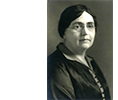|
R E G I S T R Y D A T A B A S E • G E N E R A L
|
 |
For the Kelsey excavations of 1925, we have the registry card system created under the supervision of E. E. Peterson and E. R. Stoever, but many were recorded in detail by Orma F. Butler (left) and her sister Anita “Nita” Butler (see sample under the contents tab). Their intention was to export artifacts to Ann Arbor for specialists to study, where they might have received some other alpha-numerical designation, but this opportunity never arose. Only very basic preliminary descriptions survive on registry cards and in field diaries.
|
|
For the Stager excavations 1976-79, the recording system developped at Tell el-Hesi ( Blakely and Toombs 1980) and refined at Idalion was continued, but with innovations introduced during the first season at the commercial harbor by Sandra Woolfrey (1975). On the one hand, improvements were made to facilitate the transfer of data to IBM punch cards (a project never realized); on the other, a system of prefixes in parallel registries assigned sequential numbers to specific artifact types:
GENERAL REGISTRIES • [not used] modified*
- A • botanical sample—macro
- B • botanical sample—micro
- C • coin
- D • glass
- [E flint chip]
- [F flint]
- G • geological sample
- [H human bone]
- I • worked bone & ivory
- J [animal bone] • osteological sample*
- [K lithic—small < .105m]
- [L lithic—large > .105m]
- M • metal & slag
- [N neutron activation sample]
- O • architectural feature
- P • pottery
- [Q miscellaneous]
- R • tessera
- S • shell
- T • terra cotta
- U • ¹⁴C sample
- V [inscriptions] • cippus/stela*
- W • mosaic
- X • urn contents
- [Y fresco]
- Z • statuary
This system led to duplication, with some general contents in the X- registry, for example, re-assigned new specialized numbers for further analysis (e.g. as G- geo-samples or B- botanical samples) although still a part of an urn's contents. Fragments of bone might have an X- registry and a J- registry, but re-assigned numbers were tracked so that this redundancy served to preserve contextual data.
sample:
CT_registry at OpenContext |
|
exhibition goals: The exhibit would link artifacts and samples (CT_registry) to their stratigraphic context (CT_locus) and to their graphic representations (CT_image). In order to demonstrate the development of scientific methods used in archaeological practice, over the past century and past half-century, the exhibit would pay as much attention to disciplinary standards as to aesthetic appreciation.
|
|
|
|